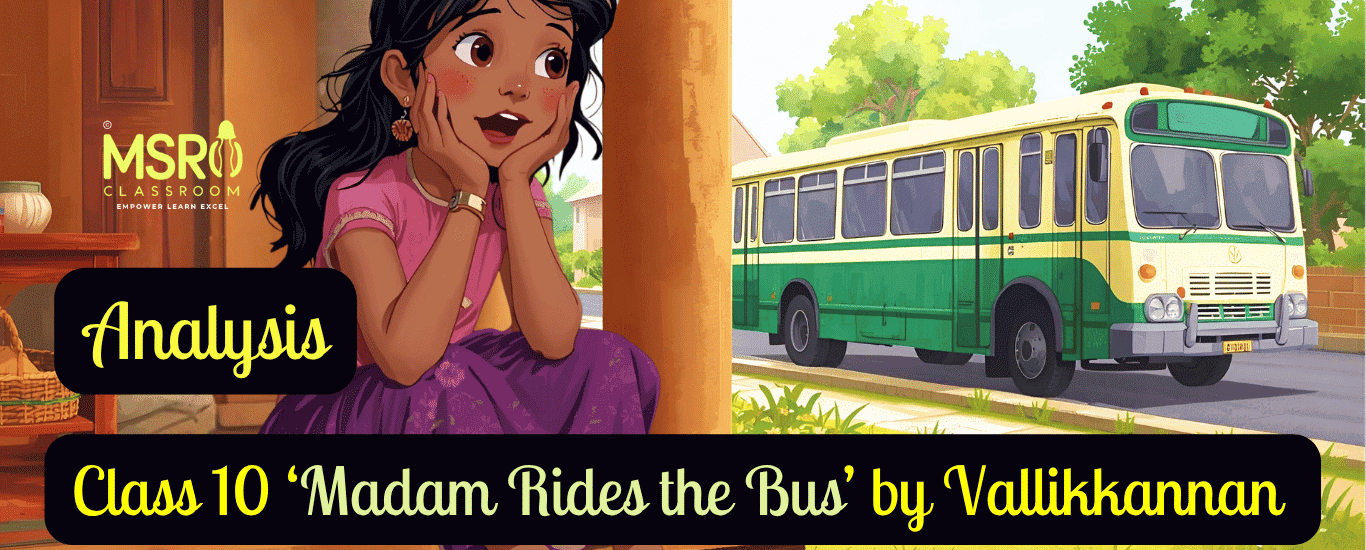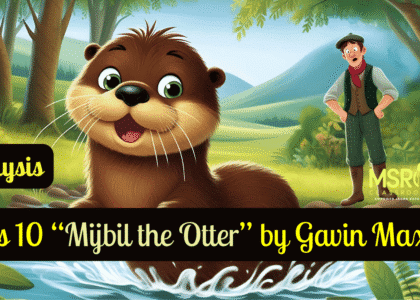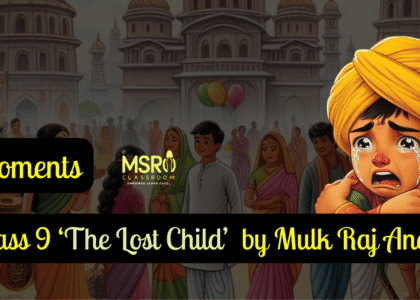Chapter 7, Vallikkannan’s ‘Madam Rides the Bus’ Summary, Word Meanings, Character Sketch, Theme, Important Passages, Question Answers with Additional Questions.
Chapter 7- Madam Rides the Bus by Vallikkannan
Table of Contents
Supplementary Reader: Class 10 ‘Footprints Without Feet‘
Vocabulary:
| Chimed in: To join in a conversation or discussion, often adding a comment. Commandingly: In a manner that shows authority or power. Curtly: In a rudely brief manner; short and abrupt. Drivel: Silly or nonsensical talk or ideas. Excursions: Short journeys or trips, especially for pleasure. Gleaming: Shining brightly. Haunted: Persistently troubled or disturbed by something. Induction: The process of introducing someone to a new experience or environment. Luxurious: Extremely comfortable, elegant, or enjoyable, especially at a great expense. Overwhelming: Very intense or powerful, often causing strong emotions. Repulsive: Causing a strong feeling of disgust or aversion. Thriftily: Carefully or economically; saving money. Wistfully: In a way that expresses a feeling of longing or yearning. |
Summary ‘Madam Rides the Bus’:
An eight-year-old girl named Valli is fascinated by a daily bus passing through her village. After saving money and carefully planning, she takes her first bus journey alone to the nearby town. During the ride, Valli enjoys the scenery and the excitement of independence.
On her way back, she sees a cow that was playful earlier but is now dead by the roadside, making her realise the harsh reality of life and death. Despite this, she keeps her experience to herself when she returns home. The story shows Valli’s curiosity and growing awareness of the world’s mysteries around her.
Explanation of ‘Madam Rides the Bus’ for Auditory Learners:
Theme of ‘Madam Rides the Bus’ by Vallikkannan:
From Innocence to Awareness:
The central theme of the story is the journey from innocence to awareness. Valli, an eight-year-old girl, is curious about the world beyond her village and excited about her first independent bus ride. Through this experience, she encounters the beauty of life, represented by the fun and excitement of the journey.
However, when she sees the dead cow on the return trip, Valli is confronted with the harsh reality of death. The story highlights the contrast between childhood innocence and the inevitable realisation of life’s deeper truths. It also emphasises the importance of independence and personal growth as Valli navigates her journey alone.
Character Sketch of Valli in ‘Madam Rides the Bus’:
1. Appearance:
- A lively and energetic eight-year-old girl.
- Bright eyes filled with curiosity.
2. Initial Traits:
- Inquisitive: Always eager to know about the world outside her village.
- Innocent: Limited understanding of life’s harsh realities but highly observant.
3. Personality:
- Independent: Strong-willed and prefers doing things her way.
- Adventurous: Deeply desires to explore beyond her village.
- Bold: Unafraid to pursue her dream, even without her family’s knowledge.
4. Actions:
- Clever: Saves money meticulously to fulfill her dream of riding the bus.
- Resourceful: Convinces the bus conductor to allow her to ride alone without her mother’s knowledge.
- Secretive: She keeps her bus journey a secret from her mother.
5. Characteristics:
- Brave: Takes bold steps to experience something new, undeterred by risks.
- Curious: Fascinated by the outside world, constantly asking questions about what she observes.
6. Growth:
- After her bus ride, she returns home with a new understanding of the world and its challenges (realising the harsh realities of death when she sees the dead cow).
- She maintains her innocence but becomes more aware of the world’s harshness.
Questions Answers ‘Madam Rides the Bus’:
| Oral Comprehension Check: Q1: What was Valli’s favourite pastime? A1: Valli’s favourite pastime was watching the bus between her village and the nearest town. She enjoyed seeing the bus and imagining what it would be like to ride on it. Q2: What was a source of unending joy for Valli? What was her strongest desire? A2: The bus was a source of unending joy for Valli. Her strongest desire was to ride on the bus just once to experience the excitement of travelling to town. Q3: What did Valli find out about the bus journey? How did she find out these details? A3: Valli found out that the bus journey was exciting and full of interesting things to see. She learned these details by observing the bus, talking to people, and listening to their stories about their trips. Q4: What do you think Valli was planning to do? A4: Valli planned to take a bus to the town. She wanted to experience the journey and see all the beautiful sights she had heard about. Q5: Why does the conductor call Valli ‘madam’? A5: The conductor calls Valli ‘madam’ to show respect. He indulges in making her feel like someone important, a grown-up, and necessary because she paid for her ticket and travelled alone. Q6: Why does Valli stand up on the seat? What does she see now? A6: Valli stands up in her seat to get a better view outside the bus. From there, she can see the beautiful landscape, including the fields, trees, and animals, which makes her feel excited and happy. Q7: What does Valli tell the elderly man when he calls her a child? A7: When the elderly man calls her a child, Valli confidently tells him she is not a child. She wants to show that she is independent and can care for herself. Q8: Why didn’t Valli want to make friends with the elderly woman? A8: Valli didn’t want to make friends with the elderly woman because she found her annoying. The woman kept asking Valli if she was safe and warned her about being careful, which frustrated Valli. Q9: How did Valli save up money for her first journey? Was it easy for her? A9: Valli saved money for her first journey by not spending on small things, like snacks or toys. She collected coins daily and worked hard to save thirty paise for the bus ticket. It wasn’t easy, but she was determined to go on the trip. Q10: What did Valli see on her way that made her laugh? A10: Valli saw a young cow running fast with its tail in the air on her way. It made her laugh because the cow looked silly and happy, which filled her with joy. Q11: Why didn’t she get off the bus at the bus station? A11: Valli didn’t get off the bus at the bus station because she wanted to keep riding the bus and explore more. She was curious and excited to see what else was out there. Q12: Why didn’t Valli want to go to the stall and have a drink? What does this tell you about her? A12: Valli didn’t want to go to the stall for a drink because she didn’t want to spend her money and also wanted to remain independent. It shows that she is confident, mature, and focused on her adventure rather than comfort. |
Q1: What was Valli’s deepest desire? Find the words and phrases in the story that tell you this.
A1: Valli’s deepest desire was to ride the bus between her village and the nearest town. Several words and phrases in the story show this desire:
- “a tiny wish crept into her head” – indicates that her desire started small but grew stronger over time.
- “overwhelming desire” – shows how strong her wish became.
- “stare wistfully at the people” – Valli looked longingly at the people getting on and off the bus, showing her longing to join them.
- “She wanted to ride on that bus, even if just once” – directly expresses her desire to experience the bus journey.
These phrases show that Valli was not just curious about the bus; she truly wanted to experience the adventure for herself.
Q2: How did Valli plan her bus ride? What did she find out about the bus, and how did she save up the fare?
A2: Valli carefully planned her bus ride in several ways:
- Learning About the Bus: Valli listened to conversations with her neighbours and asked discreet questions. She found out that the bus travelled to the town six miles away and charged thirty paise one way.
- Calculating the Fare: She learned that she needed sixty paise for a round trip (to the town and back), which was important for her plan.
- Saving Money: Valli saved money by resisting the temptation to buy peppermints, toys, and balloons. She saved every stray coin she could find.
- Choosing the Right Time: She waited for the right moment to sneak out of her house while her mother was napping. This way, she could go on her adventure without anyone noticing.
Through careful planning and saving, Valli was able to make her dream of riding the bus come true.
Q3: What kind of a person is Valli? To answer this question, pick out the following sentences from the text and fill in the blanks. The words you fill in are the clues to your answer.
A3: Valli is a confident and determined person. Here are the filled-in sentences with clues about her character:
(i) “Stop the bus! Stop the bus!” And a tiny hand was raised demandingly.
(ii) “Yes, I want to go to town,” said Valli, still standing outside the bus.
(iii) “There’s nobody here but me,” she said haughtily. “I’ve paid my thirty paise like everyone else.”
(iv) “Never mind,” she said, “I can manage. You don’t have to help me. I’m not a child, I tell you,” she said, defiantly.
(v) “You needn’t bother about me. I can take care of myself,” Valli said, turning her face toward the window and staring out.
(vi) Then she turned to the conductor and said, “Well, sir, I hope you will not mind.”
These sentences show that Valli is independent, assertive, and self-reliant. She stands up for herself and knows what she wants.
Q4: Why does the conductor refer to Valli as ‘madam’?
A4: The conductor refers to Valli as “madam” because she acts confidently and knows what she wants. By using this term, he is being polite and respectful. Even though Valli is just a young girl, she behaves like an adult by standing up for herself and insisting on taking the bus alone. Her mannerisms show her maturity and capability, so the conductor treats her respectfully.
Q5: Find the lines in the text which tell you that Valli was enjoying her ride on the bus.
A5: Here are some lines from the text that indicate Valli was enjoying her bus ride, including the cow scene:
- “Valli devoured everything with her eyes.”
- “Her face was beaming with endless joy.”
- “Oh, it was all so wonderful!”
- “Look at that cow!” she said, pointing with glee.”
Q6: Why does Valli refuse to look out of the window on her way back?
A6: Valli refuses to look out the window on her way back because she has realised the harsh realities of life. During her bus ride, she sees a cow knocked down by a vehicle, which profoundly affects her. The sight makes her aware of the sadness and suffering that can exist in the world.
By choosing not to look outside, she is trying to shield herself from these unpleasant truths and the emotions that come with them. Valli understands that while she enjoyed her adventure, life also includes moments of pain and loss, and she prefers to keep her joyful memories intact.
Q7: What does Valli mean when she says, “I was just agreeing with what you said about things happening without our knowledge.”
A7: When Valli says, “I was just agreeing with what you said about things happening without our knowledge,” she acknowledges that there are many things in life that we cannot see or understand. She reflects on how unexpected events can occur, like the tragic incident with the cow she witnessed.
The statement shows that Valli has gained insight from her experiences. She realises that life is full of surprises and that sometimes bad things happen without warning. By agreeing with this idea, Valli expresses her growing awareness of the complexity of life and how much we may not know about the world around us.
Q8: The author describes the things that Valli sees from an eight-year-old’s point of view. Can you find evidence from the text for this statement?
A8: The author describes Valli’s experiences from an eight-year-old’s point of view by using simple language and capturing her curiosity and excitement.
- Curiosity About the World: Valli’s excitement about the bus ride is shown when she says, “I want to see what is there in the town.” It reflects her eagerness and childlike curiosity about the new experiences that await her.
- Imagining the Journey: When Valli observes the scenery, she is fascinated by the sights, such as the “green fields and the tall trees.” Her wonder at the landscape captures how children view the world with fresh eyes, finding joy in simple things.
- Emotional Reactions: After witnessing the cow being hit by the bus, Valli’s shock is evident when she says, “Oh, how terrible!” The reaction showcases her innocence and how deeply she feels for the animal, which is a common trait in children who are sensitive to the suffering of others.
- Interactions with Adults: Valli’s playful banter with the conductor, where she insists on being treated like an adult, shows her childlike desire for independence. When she says, “I’m not a child, I tell you,” it reflects her eagerness to assert herself, typical of a child wanting to grow up quickly.
Writing:
Write a page — about three paragraphs — on one of the following topics.
- Are you concerned about traffic and road safety? What are your concerns? How would you make road travel safer and more enjoyable?
| Yes, I am very concerned about traffic and road safety. Many people get hurt or even lose their lives in accidents every year. I worry about how fast some cars go and how drivers sometimes do not pay attention. For example, I often see people using their phones while driving, which is dangerous. Also, I noticed that many drivers do not stop at red lights or do not watch for pedestrians at crosswalks. All these behaviours can lead to serious accidents and injuries. We need better education for drivers and pedestrians to make road travel safer. Schools should teach children about road safety from a young age. For example, kids should learn to look both ways before crossing the street and to use pedestrian signals. Drivers should also attend classes on safe driving habits and avoiding distractions like texting. Further, stricter laws and penalties for speeding or reckless driving can help make the roads safer for everyone. Finally, I believe we can make road travel more enjoyable by improving the streets and making them more accessible. We can add more bike lanes and walking paths so that people have safe options besides cars. Parks or resting areas along busy roads can provide safe spots for families to stop and enjoy the outdoors. If we work together to make these changes, we can create a safer and more enjoyable environment for everyone who travels on the road. |
Extra Questions ‘Madam Rides the Bus’:
Short Answer Type Questions:
Q1: Why was Valli so eager to ride the bus?
A1: Valli was eager to ride the bus because she found it fascinating. She loved watching the bus pass by her village daily and dreamed of being one of the passengers. Exploring the world beyond her town determined her to take the bus ride.
Q2: How did Valli manage to save money for the bus ride?
A2: Valli saved money for the bus ride by being careful with her coins. She avoided spending on things like toys, balloons, and sweets. She even resisted riding the merry-go-round at the village fair to ensure she had enough for her trip.
Q3: What were some sights that fascinated Valli during the bus ride?
A3: During the bus ride, Valli was amazed by the beautiful green fields, the distant mountains, and the blue sky. She also loved watching the canal and palm trees. Seeing a cow running in front of the bus made her laugh joyfully.
Q4: How did Valli react when she saw the dead cow on her return trip?
A4: Valli felt very sad when she saw the dead cow on her return trip. It was the same cow she had laughed at earlier, and now it looked lifeless and frightening. The sight made her quiet and took away her excitement for the rest of the journey.
Q5: How did Valli’s mother react when she returned home?
A5: Valli’s mother didn’t notice anything unusual when she returned home. She was busy talking to her aunt and casually asked Valli where she had been without expecting a reply. Valli smiled to herself, keeping her adventure a secret, and her mother continued with the conversation.
Q6: How did Valli prepare for her first bus journey?
A6: Valli carefully saved sixty paise by resisting the temptation to buy treats like toys or peppermints. She also made plans to slip out while her mother was napping in the afternoon. She gathered all the details about the bus journey by listening to others and asking questions.
Q7: What was Valli’s interaction with the bus conductor like?
A7: The bus conductor was friendly and joked with Valli, calling her “madam” and treating her like an adult. However, Valli insisted she was not a “madam” and could manage everything herself. Their playful interaction made everyone on the bus laugh, including Valli.
Q8: Why did Valli refuse the conductor’s offer to buy her a drink?
A8: Valli refused the conductor’s offer to buy her a drink because she wanted to be independent and didn’t want to accept anything from strangers. She proudly told the conductor she had money and didn’t need anyone’s help, showing her self-reliant attitude.
Q9: How did Valli’s life and death experience change after seeing the dead cow?
A9: Valli was initially excited during her bus ride but was deeply affected after seeing the dead cow. It made her realise the harsh realities of life and death, leaving her quiet and thoughtful for the rest of the journey—a clear shift in her mood.
Q10: What role does curiosity play in Valli’s character throughout the story?
A10: Curiosity drives Valli’s actions throughout the story. Her desire to explore the world beyond her village motivates her to take the bus ride. She observes everything with excitement and wonder, always eager to learn more. However, her curiosity also leads her to confront complex realities like death.
Q11: Why didn’t Valli appreciate the elders’ care on her bus journey?
A11: Valli didn’t appreciate the elders’ care on her bus journey because she felt independent and capable of caring for herself. She believed she was mature enough to handle the experience alone and found their concern or interference unnecessary. Valli wanted to prove she didn’t need anyone’s help or advice.
Long Answer Type Questions:
Q1: What motivates Valli to take her first bus ride, and how does she prepare for the journey?
A1: An eight-year-old girl, Valli, is motivated to take her first bus ride because she is curious about the world outside her village. She often watches the bus pass by and dreams of experiencing the excitement of a journey. To prepare, Valli saves money by resisting the urge to buy treats and toys, gathering sixty paise.
She carefully plans to leave her house without her mother noticing, taking advantage of her mother’s afternoon nap. It shows her determination and desire for independence. Valli’s excitement builds as she imagines what the town will be like, and she is eager to explore beyond her familiar surroundings, making her journey a significant milestone in her young life.
Q2: Describe Valli’s observations during her bus journey to the town. What does she find fascinating, and how does it contrast with her life in the village?
A2: Valli observes many exciting sights during her bus journey to the town. She sees beautiful landscapes with palm trees, green fields, and distant mountains, different from her simple village life. The bus has new passengers, and Valli feels special sitting comfortably. She finds joy in watching the lively streets and the busy shops in the town.
It contrasts sharply with her quiet village, where no playmates or exciting experiences exist. The town’s vibrant colours, sounds, and bustling activity captivate her. Valli’s observations highlight her curiosity and desire for adventure, making the journey a thrilling exploration of a world beyond her own.
Q3: How does Valli react to the encounter with the dead cow on her return journey, and what does this reveal about her understanding of life and death?
A3: When Valli sees the dead cow on her return journey, she is shocked and saddened. Earlier, she found the cow amusing when it ran in front of the bus, but now, its lifeless body frightens her. The encounter marks a turning point in Valli’s understanding of life and death.
She realises that life can end suddenly, and death takes away the beauty and joy she once saw in the cow. The moment makes her feel heavy-hearted, and she no longer wants to look out the window. Valli’s reaction shows that she is beginning to understand the seriousness of life and the reality of death, moving from innocence to a deeper awareness of the world around her.
Q4: What does Valli’s interaction with the conductor during her bus ride reveal about her character and desire for independence?
A4: Valli’s interaction with the conductor shows her strong desire for independence and confidence. When she first boards the bus, she asserts herself by insisting she can get on without help, demonstrating her determination to be treated like an adult.
Throughout the ride, she argues with the conductor, insisting she is not a child, even though she is only eight. Valli’s refusal to accept help or to be treated as a little girl highlights her eagerness to experience the world on her terms. She wants to prove that she can travel alone and enjoy the bus without relying on anyone. The desire for independence reflects her curiosity and adventurous spirit.
Q5: In what ways does the story highlight the gap between childhood innocence and the realities of life? Provide examples from Valli’s experiences.
A5: The story highlights the gap between childhood innocence and life’s realities through Valli’s experiences. Initially, Valli is excited about her bus ride, filled with joy and curiosity. She imagines the town as magical, showing her innocent view of the world. However, her encounter with the dead cow on the road shocks her and brings her face to face with the harsh realities of life.
The incident shifts her perspective, revealing that life can be sad and difficult. Valli’s excitement contrasts sharply with the world’s severe and sometimes unpleasant aspects. Ultimately, her journey illustrates how children can experience joy while confronting life’s challenging truths, marking a significant moment in her understanding of the world.
Important Excerpts from ‘Madam Rides the Bus’:
1. Valli’s Curiosity:
“There was a girl named Valliammai who was called Valli for short. She was eight years old and very curious about things.”
Context: The opening introduces Valli, an eight-year-old girl characterised by her strong curiosity about the world. Her name, Valliammai, is shortened to Valli, indicating her youthful nature. It sets the tone for her exploration and adventure throughout the story.
2. Watching the Bus:
“The most fascinating thing of all was the bus that travelled between her village and the nearest town.”
Context: Valli is captivated by the bus that connects her village to the town. The bus symbolises adventure and freedom, representing everything outside her small, familiar world. Her fascination with it is central to her character and plot.
3. Valli’s Determination:
“Day after day she watched the bus, and gradually a tiny wish crept into her head and grew there: she wanted to ride on that bus, even if just once.”
Context: Valli’s growing desire to ride the bus shows her determination and longing for independence. The “tiny wish” becomes a significant goal for her, reflecting the universal childhood desire to explore and experience new things.
4. The Journey Begins:
“The bus slowed down to a crawl, and the conductor… said, ‘Hurry then! Tell whoever it is to come quickly.’”
Context: As Valli prepares for her journey, the bus slows down, and the conductor urges her to hurry. This moment builds excitement and anticipation for Valli’s first ride, marking a pivotal point in the story where she steps towards her dream.
5. Valli’s Pride:
“There’s nobody here who’s a child,” she said haughtily. “I’ve paid my thirty paise like everyone else.”
Context: Valli asserts her independence and equality by stating that she has paid the fare like everyone else. This moment reflects her confidence and pride, emphasising that she can care for herself despite her young age.
6. Valli’s Assertiveness:
“But the old woman went on with her drivel. “Is it proper for such a young person to travel alone? Do you know exactly where you’re going in town? What’s the street? What’s the house number?”
Valli’s excitement is palpable as she sees the beauty of the landscape from the bus. Her initial joy is contrasted with her annoyance at an elderly passenger’s concern for her safety, which reflects her strong desire to assert her independence.
6. Joy and Laughter:
“Valli clapped her hands with glee. A young cow, tail high in the air, was running very fast…”
Context: Valli’s delight in witnessing a young cow running alongside the bus showcases her playful spirit and innocence. The joyful moment highlights the beauty of the journey and Valli’s ability to find happiness in simple, everyday occurrences.
7. The Dead Cow:
“‘Isn’t that the same cow that ran in front of the bus on our trip to town?’ she asked the conductor.”
Context: Valli’s observation about the dead cow introduces a more serious theme. It connects her joyful adventure to the realities of life and death. The moment represents a significant learning experience for Valli, prompting her to reflect on the cycle of life.
8. Reflection on Knowledge:
“Yes, you’re right… How can we possibly know about everything? And even when we do know about something, we often can’t understand it completely, can we?”……………..“Oh,” said Valli, “I was just agreeing with what you said about things happening without our knowledge.”
Context: Valli’s conversation with her mother and aunt highlights the theme of understanding life’s mysteries. Her smile symbolises her newfound wisdom and the realisation that even adults struggle to comprehend everything. This ties back to her journey, showing how her experience has enriched her perspective.
9. Valli’s Smile:
“Valli smiled to herself. She didn’t want them to understand her smile. But, then, there wasn’t much chance of that, was there?”
Context: Valli’s smile at the end suggests her acceptance of life’s uncertainties and the limits of understanding. It captures her maturity as she recognises that not everything can be known or explained, highlighting her growth throughout the story.





